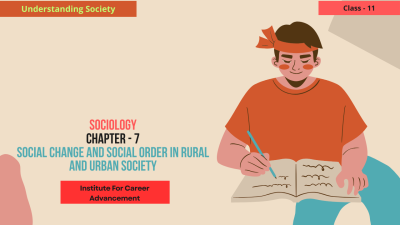Course description
The Class 11 Sociology chapter on "Social Change and Social Order in Rural and Urban Society" explores the dynamics of social change and the mechanisms that maintain social order in both rural and urban settings. The chapter provides a comparative analysis of how change and stability are experienced in different types of societies and the factors that influence these processes. It covers key sociological concepts, theories, and real-world examples to help students understand how societies adapt to changes while maintaining order.
Course Overview:
1. Introduction to Social Change and Social Order
Social Change: Understanding the meaning of social change and its significance in both rural and urban contexts.
Social Order: Examining how societies maintain stability, coherence, and order despite ongoing changes.
Interrelation: Understanding the balance between change and stability in society.
2. Factors Influencing Social Change
Technological Advancements: The role of technology in transforming societies, especially in communication, transportation, and agriculture.
Economic Factors: How industrialization, urbanization, and changes in the economic structure drive social change.
Political Factors: The influence of government policies, political movements, and legal reforms on societal transformation.
Cultural Factors: The role of ideas, beliefs, values, and education in shaping social change.
Environmental Factors: How geographical and environmental conditions affect rural and urban societies.
3. Social Change in Rural Society
Characteristics of Rural Society: Understanding the traditional social structures, such as kinship, caste, and community relations, in rural areas.
Processes of Change: Examining how factors like modernization, migration, land reforms, and government schemes contribute to changes in rural society.
Challenges in Rural Development: Issues such as poverty, lack of infrastructure, and education in the process of rural social change.
Impact of Globalization: How globalization is reshaping rural economies, social relations, and agricultural practices.
4. Social Change in Urban Society
Characteristics of Urban Society: Understanding the diverse and heterogeneous nature of urban societies, characterized by anonymity, formal relationships, and a division of labor.
Urbanization and its Effects: The process of urbanization and its consequences, including changes in family structures, lifestyles, and social interactions.
Migration and Urban Growth: Examining the role of rural-urban migration in shaping urban spaces, labor markets, and population dynamics.
Challenges of Urbanization: Issues such as housing shortages, environmental degradation, unemployment, and social inequality in urban areas.
5. Social Order in Rural Society
Traditional Social Structures: How systems like caste, kinship, and village communities contribute to maintaining social order in rural areas.
Role of Customs and Traditions: The importance of customs, rituals, and local institutions in ensuring stability and social harmony in rural settings.
Role of Panchayats and Local Governance: The contribution of local governance structures like panchayats in regulating rural life and maintaining order.
6. Social Order in Urban Society
Formal Institutions and Social Order: The role of formal institutions, including the police, judiciary, and municipal bodies, in maintaining law and order in cities.
Social Norms and Public Behavior: How informal social norms and expectations regulate individual behavior in urban settings.
Civil Society and Social Movements: The role of NGOs, citizen groups, and social movements in advocating for social justice and maintaining order in urban areas.
7. Comparing Rural and Urban Societies
Contrasts in Social Structures: Comparing the role of traditional institutions in rural areas with formal institutions in urban areas.
Differences in Social Change: Understanding how social change is experienced differently in rural and urban contexts, with urban areas often witnessing faster changes due to industrialization and globalization.
Interdependence of Rural and Urban Areas: Recognizing how rural and urban societies are interdependent, especially in terms of migration, economic exchange, and resource allocation.
8. Theories of Social Change and Social Order
Functionalist Perspective: How functionalism explains the need for social institutions in maintaining order and stability amidst social change.
Conflict Perspective: Examining how social change is driven by conflict and power struggles, especially in the context of class and caste differences.
Symbolic Interactionism: Understanding how individuals and groups negotiate social change and order through everyday interactions and social symbols.
"গ্রামীণ ও শহুরে সমাজে সামাজিক পরিবর্তন ও সামাজিক শৃঙ্খলা" শীর্ষক 11 তম শ্রেণীর সমাজবিজ্ঞান অধ্যায়টি সামাজিক পরিবর্তনের গতিশীলতা এবং গ্রামীণ ও শহুরে উভয় পরিবেশে সামাজিক শৃঙ্খলা বজায় রাখার প্রক্রিয়াগুলি অন্বেষণ করে। এই অধ্যায়টি বিভিন্ন ধরনের সমাজে কীভাবে পরিবর্তন ও স্থিতিশীলতা অনুভব করা হয় এবং এই প্রক্রিয়াগুলিকে প্রভাবিত করে এমন কারণগুলির একটি তুলনামূলক বিশ্লেষণ প্রদান করে। শৃঙ্খলা বজায় রেখে সমাজ কীভাবে পরিবর্তনের সঙ্গে খাপ খাইয়ে নেয় তা বুঝতে শিক্ষার্থীদের সহায়তা করার জন্য এটি মূল সমাজতাত্ত্বিক ধারণা, তত্ত্ব এবং বাস্তব-বিশ্বের উদাহরণগুলি অন্তর্ভুক্ত করে।
কোর্স ওভারভিউঃ
1টি। সামাজিক পরিবর্তন ও সামাজিক শৃঙ্খলার পরিচিতি
সামাজিক পরিবর্তনঃ সামাজিক পরিবর্তনের অর্থ এবং গ্রামীণ ও শহুরে উভয় প্রেক্ষাপটে এর তাৎপর্য বোঝা।
সামাজিক শৃঙ্খলাঃ চলমান পরিবর্তন সত্ত্বেও সমাজ কীভাবে স্থিতিশীলতা, সংহতি এবং শৃঙ্খলা বজায় রাখে তা পরীক্ষা করা।
আন্তঃসম্পর্কঃ সমাজে পরিবর্তন এবং স্থিতিশীলতার মধ্যে ভারসাম্য বোঝা।
2. সামাজিক পরিবর্তনকে প্রভাবিত করার কারণগুলি
প্রযুক্তিগত অগ্রগতিঃ সমাজ পরিবর্তনের ক্ষেত্রে প্রযুক্তির ভূমিকা, বিশেষ করে যোগাযোগ, পরিবহন এবং কৃষিতে।
অর্থনৈতিক কারণঃ শিল্পায়ন, নগরায়ন এবং অর্থনৈতিক কাঠামোর পরিবর্তন কীভাবে সামাজিক পরিবর্তনকে চালিত করে।
রাজনৈতিক কারণঃ সামাজিক রূপান্তরের উপর সরকারি নীতি, রাজনৈতিক আন্দোলন এবং আইনি সংস্কারের প্রভাব।
সাংস্কৃতিক কারণঃ সামাজিক পরিবর্তন গঠনে ধারণা, বিশ্বাস, মূল্যবোধ এবং শিক্ষার ভূমিকা।
পরিবেশগত কারণঃ ভৌগলিক ও পরিবেশগত পরিস্থিতি কীভাবে গ্রামীণ ও শহুরে সমাজকে প্রভাবিত করে।
3. গ্রামীণ সমাজে সামাজিক পরিবর্তন
গ্রামীণ সমাজের বৈশিষ্ট্যঃ গ্রামাঞ্চলে আত্মীয়তা, বর্ণ এবং সম্প্রদায়ের সম্পর্কের মতো ঐতিহ্যবাহী সামাজিক কাঠামো বোঝা।
পরিবর্তনের প্রক্রিয়াঃ আধুনিকীকরণ, অভিবাসন, ভূমি সংস্কার এবং সরকারি প্রকল্পগুলির মতো বিষয়গুলি কীভাবে গ্রামীণ সমাজের পরিবর্তনে অবদান রাখে তা পরীক্ষা করা।
গ্রামীণ উন্নয়নের চ্যালেঞ্জঃ গ্রামীণ সামাজিক পরিবর্তনের প্রক্রিয়ায় দারিদ্র্য, পরিকাঠামোর অভাব এবং শিক্ষার মতো বিষয়।
বিশ্বায়নের প্রভাবঃ বিশ্বায়ন কীভাবে গ্রামীণ অর্থনীতি, সামাজিক সম্পর্ক এবং কৃষি পদ্ধতিকে নতুন আকার দিচ্ছে।
4. শহুরে সমাজে সামাজিক পরিবর্তন
শহুরে সমাজের বৈশিষ্ট্যসমূহঃ শহুরে সমাজের বৈচিত্র্যময় এবং বৈচিত্র্যময় প্রকৃতি বোঝা, নামহীনতা, আনুষ্ঠানিক সম্পর্ক এবং শ্রম বিভাজন দ্বারা চিহ্নিত।
নগরায়ন এবং এর প্রভাবঃ নগরায়ণের প্রক্রিয়া এবং পারিবারিক কাঠামো, জীবনধারা এবং সামাজিক মিথস্ক্রিয়ার পরিবর্তন সহ এর পরিণতি।
অভিবাসন ও শহুরে প্রবৃদ্ধিঃ শহুরে স্থান, শ্রম বাজার এবং জনসংখ্যার গতিশীলতা গঠনে গ্রামীণ-শহুরে অভিবাসনের ভূমিকা পরীক্ষা করা।
নগরায়নের চ্যালেঞ্জঃ আবাসন ঘাটতি, পরিবেশের অবনতি, বেকারত্ব এবং শহরাঞ্চলে সামাজিক বৈষম্যের মতো বিষয়।
5. গ্রামীণ সমাজে সামাজিক শৃঙ্খলা
ঐতিহ্যবাহী সামাজিক কাঠামোঃ কীভাবে বর্ণ, আত্মীয়তা এবং গ্রামীণ সম্প্রদায়ের মতো ব্যবস্থা গ্রামাঞ্চলে সামাজিক শৃঙ্খলা বজায় রাখতে অবদান রাখে।
রীতিনীতি ও ঐতিহ্যের ভূমিকাঃ গ্রামীণ পরিবেশে স্থিতিশীলতা ও সামাজিক সম্প্রীতি নিশ্চিত করতে রীতিনীতি, আচার-অনুষ্ঠান এবং স্থানীয় প্রতিষ্ঠানের গুরুত্ব।
পঞ্চায়েত ও স্থানীয় প্রশাসনের ভূমিকাঃ গ্রামীণ জীবন নিয়ন্ত্রণ ও শৃঙ্খলা বজায় রাখতে পঞ্চায়েতের মতো স্থানীয় শাসন কাঠামোর অবদান।
6টি। শহুরে সমাজে সামাজিক শৃঙ্খলা
আনুষ্ঠানিক প্রতিষ্ঠান ও সামাজিক শৃঙ্খলাঃ শহরে আইন-শৃঙ্খলা বজায় রাখতে পুলিশ, বিচার বিভাগ এবং পৌর সংস্থাসহ আনুষ্ঠানিক প্রতিষ্ঠানের ভূমিকা।
সামাজিক নিয়ম এবং জনসাধারণের আচরণঃ কীভাবে অনানুষ্ঠানিক সামাজিক নিয়ম এবং প্রত্যাশা শহুরে পরিবেশে ব্যক্তিগত আচরণ নিয়ন্ত্রণ করে।
নাগরিক সমাজ ও সামাজিক আন্দোলনঃ সামাজিক ন্যায়বিচারের পক্ষে ও শহরাঞ্চলে শৃঙ্খলা বজায় রাখতে এনজিও, নাগরিক গোষ্ঠী এবং সামাজিক আন্দোলনের ভূমিকা।
7. গ্রামীণ ও শহুরে সমাজের তুলনা সামাজিক কাঠামোর মধ্যে বৈপরীত্যঃ গ্রামীণ এলাকায় ঐতিহ্যবাহী প্রতিষ্ঠানের ভূমিকার সঙ্গে শহুরে এলাকায় আনুষ্ঠানিক প্রতিষ্ঠানের ভূমিকার তুলনা।
সামাজিক পরিবর্তনের পার্থক্যঃ গ্রামীণ ও শহুরে প্রেক্ষাপটে সামাজিক পরিবর্তন কীভাবে ভিন্নভাবে অনুভূত হয় তা বোঝা, যেখানে শিল্পায়ন ও বিশ্বায়নের কারণে শহুরে অঞ্চলগুলি প্রায়শই দ্রুত পরিবর্তন প্রত্যক্ষ করে।
গ্রামীণ ও শহুরে এলাকার পারস্পরিক নির্ভরতাঃ গ্রামীণ ও শহুরে সমাজ কীভাবে আন্তঃনির্ভরশীল তা স্বীকৃতি দেওয়া, বিশেষত অভিবাসন, অর্থনৈতিক বিনিময় এবং সম্পদ বরাদ্দের ক্ষেত্রে।
8. সামাজিক পরিবর্তন ও সামাজিক শৃঙ্খলার তত্ত্ব
কার্যকরী দৃষ্টিভঙ্গিঃ সামাজিক পরিবর্তনের মধ্যে শৃঙ্খলা ও স্থিতিশীলতা বজায় রাখতে সামাজিক প্রতিষ্ঠানের প্রয়োজনীয়তা কীভাবে কার্যকারিতা ব্যাখ্যা করে।
দ্বন্দ্ব দৃষ্টিভঙ্গিঃ সামাজিক পরিবর্তন কীভাবে দ্বন্দ্ব এবং ক্ষমতার সংগ্রাম দ্বারা চালিত হয় তা পরীক্ষা করা, বিশেষত শ্রেণী ও বর্ণের পার্থক্যের প্রেক্ষাপটে।
প্রতীকী মিথস্ক্রিয়াবাদঃ দৈনন্দিন মিথস্ক্রিয়া এবং সামাজিক প্রতীকগুলির মাধ্যমে ব্যক্তি এবং গোষ্ঠীগুলি কীভাবে সামাজিক পরিবর্তন এবং শৃঙ্খলা নিয়ে আলোচনা করে তা বোঝা।



















